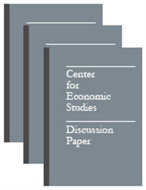
An official website of the United States government
Here’s how you know
Official websites use .gov
A .gov website belongs to an official government organization in the United States.
Secure .gov websites use HTTPS
A lock (
) or https:// means you’ve safely connected to the .gov website. Share sensitive information only on official, secure websites.
-
//
- Census.gov /
- Library /
- Census Working Papers /
- Innovation, Reallocation And Growth
Innovation, Reallocation And Growth
Innovation, Reallocation And Growth
Abstract
We build a model of firm-level innovation, productivity growth and reallocation featuring endogenous entry and exit. A key feature is the selection between high- and low-type firms, which differ in terms of their innovative capacity. We estimate the parameters of the model using detailed US Census micro data on firm-level output, R&D and patenting. The model provides a good fit to the dynamics of firm entry and exit, output and R&D, and its implied elasticities are in the ballpark of a range of micro estimates. We find industrial policy subsidizing either the R&D or the continued operation of incumbents reduces growth and welfare. For example, a subsidy to incumbent R&D equivalent to 53 of GDP reduces welfare by about 1.53 because it deters entry of new high-type firms. On the contrary, substantial improvements (of the order of 53 improvement in welfare) are possible if the continued operation of incumbents is taxed while at the same time R&D by incumbents and new entrants is subsidized. This is because of a strong selection effect: R&D resources (skilled labor) are inefficiently used by low-type incumbent firms. Subsidies to incumbents encourage the survival and expansion of these firms at the expense of potential high-type entrants. We show that optimal policy encourages the exit of low-type firms and supports R&D by high-type incumbents and entry.
Others in Series
Working Paper
Working Paper
Working Paper
Share
Related Information
Some content on this site is available in several different electronic formats. Some of the files may require a plug-in or additional software to view.
 Yes
Yes
 No
NoComments or suggestions?


Top

